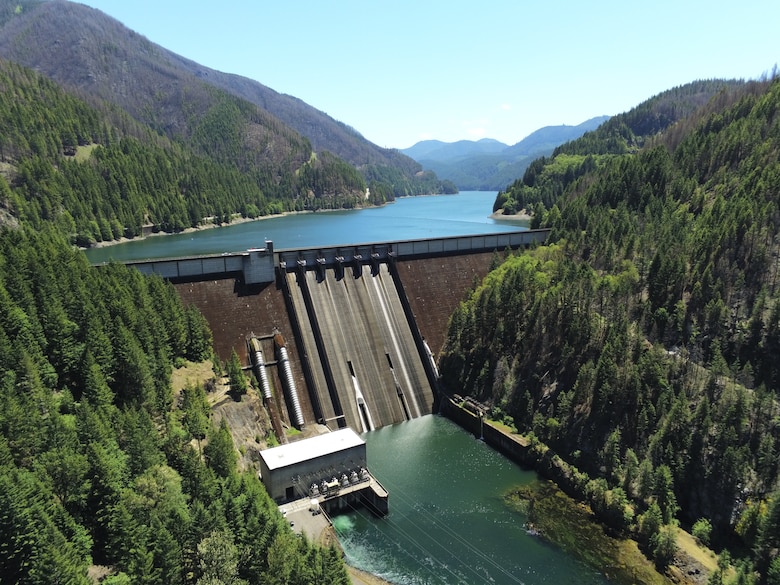
Detroit Dam, east of Salem, Ore. impounds water from the North Santiam River. Its large storage reservoir allows downstream users to have a consistent amount of water year-round but especially during long, hot summers and droughts. According to public scoping comments from city of Salem officials during a U.S. Army Corps of Engineers Draft Environmental Impact Statement (page 246) for downstream fish passage at Detroit Dam, the city’s intake for drinking water needs 750 cubic feet per second to operate (as of August 9, the combined tributaries of the North Santiam and Little North Santiam rivers were providing 413 cubic feet per second of water). (U.S. Army photo by Todd Manny)
PORTLAND, Ore. – The Portland District, U.S. Army Corps of Engineers will gather the public’s perspective and opinions on the future of hydropower across the Corps’ Willamette Valley system of dams during three listening sessions – one in-person and two virtual.
The Corps will record public input for inclusion in a report to Congress.
The Water Resources Development Act of 2022 directed the Portland District to complete a report to Congress containing information on a determination of federal interest in, and to identify the effects of, removing hydropower production as a purpose – in whole or in part – from the Corps’ Willamette Valley system of dams.
The dams serve multiple purposes in addition to hydropower production, such as flood risk management, irrigation and recreation.
“We look forward to collecting the public’s input as we prepare this report,” said Hugh Kim, the project manager for the disposition report. “This is an opportunity for the public to contribute to decisions to be made at the Congressional level.”
The listening sessions will begin with a brief introduction by Corps officials. The remainder of the session will be dedicated to collecting input.
Verbal statements received during the listening sessions will be recorded and transcribed for inclusion in the Report to Congress. We also will accept brief written statements during the listening sessions.
If you are unable to attend a listening session, an online submission form will accept written statements from Monday, Nov. 13 to midnight, Friday, Nov. 17.
Send an email on or after Monday, Nov. 13 to [email protected] for the link to the online submission form.
Virtual Listening Session #1
Monday, Nov. 13, 2023
2-4 p.m.
https://usace1.webex.com/meet/WVHydropower
Virtual Listening Session #2
Monday, Nov. 13, 2023
5:30-7:30 p.m.
https://usace1.webex.com/meet/WVHydropower
In-Person Listening Session
Tuesday, Nov. 14, 2023
5:30-7:30 p.m.
Salem Public Library, Level 1, Loucks Auditorium
585 Liberty St SE, Salem, OR 97301
The WRDA 2022 authorizes “much-needed investments in projects and programs of the U.S. Army Corps of Engineers across the country.” This bipartisan legislation ensures timely congressional authorization of Corps studies and projects.
Specifically, the law says that the study should assess:
- Whether and how discontinuing hydropower production at one or more of the eight dams would affect how those dams, other dams in the system, and the system as a whole would be operated for their other authorized purposes
- How the costs of discontinuing hydropower would be apportioned
- What impacts there would be on dam safety and compliance with the Endangered Species Act
The Corps held two information sessions in September, during which Corps experts discussed the purpose and key elements of the disposition report. Recordings of those sessions are available here: www.nwp.usace.army.mil/WRDA22-Report/
Release no. 23-018


Author: Terry Curtis
Last Updated: 1699875242
Views: 2056
Rating: 4.9 / 5 (66 voted)
Reviews: 95% of readers found this page helpful
Name: Terry Curtis
Birthday: 1969-07-10
Address: USNV Spence, FPO AE 43895
Phone: +4328776003376646
Job: Psychologist
Hobby: Horseback Riding, Cycling, Calligraphy, DIY Electronics, Cooking, Robotics, Pottery
Introduction: My name is Terry Curtis, I am a transparent, frank, expert, persistent, proficient, dazzling, daring person who loves writing and wants to share my knowledge and understanding with you.